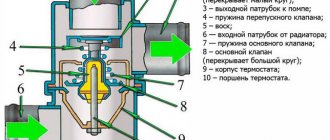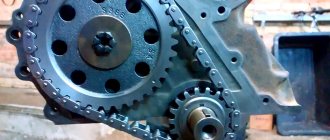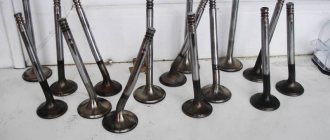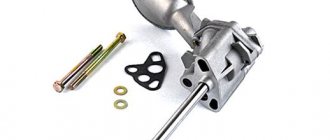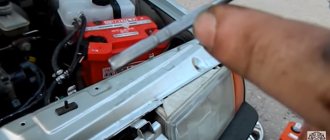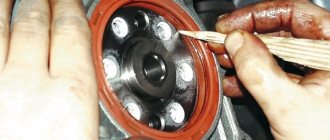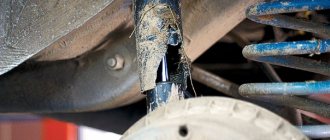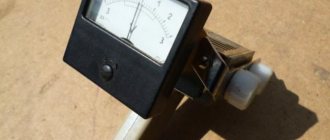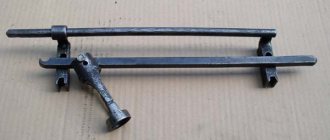Purpose and principle of operation of shock absorbers
Such a device has a typical passenger car shock absorber
A shock absorber strut is a part of a car's suspension that is designed to dampen the reciprocating movements of the wheel. Always works in conjunction with a spring or leaf spring. To understand the purpose of a shock absorber, let’s imagine for a moment what would happen if it was completely removed. What remains is a wheel capable of moving up and down, and a spring (spring).
The latter is needed to absorb shocks and support the weight of the car. If you remove the shock absorber, then when you hit the slightest hole, the wheel will sharply go down, then up, and due to the spring it will continue to swing back and forth for a very long time. As a result, you won’t get reliable contact between the tire and the road. When hitting bumps and speed bumps, the picture is even worse - an impact will follow, the car will jump, and then continue to sway, remaining uncontrollable.
An equally sad situation would arise when the weight of the car shifts, which occurs during acceleration, braking and maneuvering. In such situations, the body rolls in the direction where the mass shifts. Firstly, it greatly reduces downforce on the opposite side of the chassis. This means that handling and braking distances deteriorate. Secondly, again, due to the action of the spring and its inertia, the car will continue to swing for a long time and tediously.
Now let’s return the shock absorbers to their place and draw the situations described above again. But first, let's take a general look at how the rack works. First of all, it must be said that, roughly speaking, it connects the wheel to the car body. The shock absorber is designed in such a way that the reciprocating movements of the suspension are intentionally damped. That is, a hole, a bump, mass displacement or spring inertia are trying to sharply change the position of the wheel, and the strut is literally holding it.
It doesn't matter whether it moves up or down. But. Firstly, it does not do it as sharply as if there were no shock absorbers. Secondly, after this the body does not continue to swing up and down, since the strut dampens the inertial force of the spring or spring. In some cases, the wheel may not even have time to move. For example, in a small hole and at sufficient speed of the car. If the shock absorber holds the suspension well, the wheel will simply fly over the hole without reaching its bottom, and then without hitting it when leaving it.
Let's summarize. The task of shock absorbers is to prevent the wheels from moving up or down too sharply, and also to dampen the inertial swing of the springs.
Sway test
Now let's look at how to check the operation of the shock absorber by simply rocking the car. I would like to immediately note that the technique is not complete, because with its help it will not be possible to determine a completely failed device.
This is interesting: You can save the life of a cyclist by simply opening the car door with your right hand
The essence of the method is simple and consists in alternately rocking each side of the car. If after a vertical impact the body continues to oscillate for a long time, then the shock absorber is faulty and requires replacement (repair).
On the other hand, a quick stop after releasing the body is not a guarantee of the strength and ideal condition of the product. In some cases, the absence of fluctuations indicates a wedge, which is sometimes even worse. The ideal option is 1-2 swings after the mechanical impact has stopped.
What are the dangers of faulty shock absorbers?
Actually, some of the problems that can be encountered with worn racks are already clear from the above. Simulating situations where there are no shock absorbers at all is almost the same as if they were killed or dead. However, that's not all. Damaged, worn out or simply worn out shock absorbers can cause a lot of trouble to the car owner.
Namely:
- The comfort of the car deteriorates - it sways unpleasantly even on a flat road, knocks are heard on potholes and bumps, vibrations are felt, and so on.
- Controllability decreases - the car reacts worse to steering wheel turns, and rolls dangerously when maneuvering.
- The braking distance increases - when the front struts do not hold, during emergency braking the body sharply tilts forward, which is why the downforce on the rear axle literally disappears.
- Accelerated wear of the entire suspension - if shock absorbers allow the wheels to duplicate all the unevenness of the road, ball joints, bushings, and wheel bearings break.
- Accelerated wear of rubber - tires suffer from constant strong, unmitigated impacts and uneven loads.
- A general decrease in the safety of the car - everything comes into play here - the lack of comfort is distracting and unnerving, swaying partially reduces the downforce on the axles, the same thing when maneuvering and braking.
As a result, it turns out that checking the current condition of the shock absorbers is as important as making sure that the steering and braking systems are working. In addition, it is better to replace only the struts in a timely manner than to then make expensive overhauls of the entire chassis of the car.
Shockabsorber-replacement-14_
There are known cases when, when diagnosing a car on a “shaky ride” with a working suspension and recently replaced shock absorbers, the data obtained indicated low residual effectiveness of the suspension. But during the “test drive” the car behaved perfectly. The reason is that the stand was not designed for more “hard” settings of the tuning series shock absorbers compared to the characteristics of the original products, as a result - a wrong verdict. Well, that happens.
A very important point! The final indicators may be influenced by such parameters as tire pressure, vehicle loading during diagnostics, small deviations from a straight line when driving to the stand (appearance of a deviation angle from the longitudinal axis), accidental installation of the vehicle on the handbrake, uneven loading of the vehicle during diagnostics, etc. .d. It will be a real pleasure for a careless repairman to “cheat” a client out of the cost of new shock absorbers, so that in the meantime, as if by accident, pump up his flat tire...
When to check shock absorbers
There are several situations in the life of a car owner when diagnostics of shock absorbers are absolutely necessary. As mentioned above, timeliness is very important here. With experience, its sensation becomes automatic. But if you are a novice car enthusiast, then it probably won’t hurt you to know what to focus on.
Shock absorber struts must be checked in the following cases:
- When buying a used car , this is no less important than checking the engine. There are at least 70 percent of cars with a damaged chassis on the secondary market.
- After winter - that is, at the end of the most difficult period of the year for a car. By the way, a lot of things are checked in the spring.
- After a certain mileage , you can often find widely divergent opinions on this issue. The numbers usually jump from 40,000 km to 60,000 km. Of course, if your car “does not see” bad roads, then such mileage is quite normal for high-quality racks. As for reality, shock absorbers die much earlier. Sometimes they don’t even take care of the season, but it’s only about 10-20 thousand km.
- When general signs of wear appear , they are felt during movement, and how exactly is described below.
- If visual signs of wear appear , they are also described below, in method No. 1 of checking shock absorbers.
- After an unsuccessful hit on a bump - this is familiar to many - when you blunder or simply do not dodge a hole, followed by a characteristic blow and obscene speech.
- After a long period of parking , the shock absorber is a part that loves movement. After standing in one position for a while, he may suddenly give up.
As a result, we see that there are many reasons to check the struts in the life of a car owner, both current and future. Moreover, traffic safety, the comfort of the car, and the cost of its maintenance, in the end, depend on the condition of these parts.
Visual inspection
The first thing you need to pay attention to is the appearance of the rack itself. Sometimes it will tell you much more about its condition than other testing methods. If the stand is leaking or is wet, it is advisable to replace it. To be sure of the diagnosis, you can simply wipe the surface of the shock absorber with a dry cloth. Then repeat the inspection a few days later.
It is advisable to lift the car on a lift: the shock absorber rods should shine. If there are traces of rust or other defects, this indicates that the part is not working properly. Another indirect sign is the presence of defects on the car tires. The presence of uneven wear indicates an asymmetrical load. Among other things, it is important to assess the condition:
Summary of signs of shock absorber failure
Keep a small sign that clearly shows the main criteria for diagnosing racks discussed above, and the signs of different conditions - from ideal to rubbish.
Signs | Ideal | It might also be like | Trash |
| Smudges | Dry | There is a small leak | Wet and covered with centuries-old dust |
| Corrosion | Shines | Not shiny, but not rusty either | Rust, rot, corrosion |
| Anther | Whole, elastic and in place | Oak, but still intact and in place | Torn, cracked, slipped |
| Sleeve | Elastic, alive | Oak, but not deformed | Oak, cracked, squeezed out |
| Sway test | Freezes to the spot, returning to its original position | It swung upward once, but then sank and stopped. | Swings more than twice |
| Smooth road | The car confidently “holds” the road | Rocks or yaws for no reason | |
| Maneuvering | Little roll, instant stabilization | Noticeable roll, but no swaying | Heels heavily, and after exiting the turn continues to sway |
| Braking | One “nod” or “bow” is allowed | After the “nod” he continues to “bow” | |
| Pits | "Swallows" | There are slight impacts on the steering wheel, no knocks | Unpleasant blows to the hands and distinct knocking sounds |
| Potholes | |||
| Heat | Everyone is equally warm | One or two are a little colder than the rest | Very noticeable difference in heating |
What to do with worn racks?
There is no need to throw away used shock absorbers
There are only three answers to this question:
- Replace.
- Give it for restoration.
- Repair it yourself.
Replacement is the most expensive, but most effective way out of the situation. You can change all four racks, or only two, but always those that were on the same axis. Even if one shock absorber has exhausted its service life, they need to be renewed in pairs. The only exceptions may be those cases when you were about to install new racks, and after a couple of days (weeks) you flew into a bloodthirsty hole.
Restoration is a very good way out of the situation, but with several caveats. Yes, it's about two times cheaper than buying a new set. However, not all shock absorbers can be restored. This time. Two - a workshop that is good at doing this kind of manipulation conscientiously is not always easy to find. However, as practice shows, this is possible.
Repair . Do you know at least one ordinary car owner who has bothered himself with the restoration of shock absorber struts? The author doesn't know. You probably aren't either. If you are, then what are you doing here? You already know a lot.
Try it on!
The simplest, fairly quick and not so expensive way to get general information about the effectiveness of the suspension is to stop by a diagnostic stand, take measurements and listen to the verdict.
Another question is how precisely the verdict will apply directly to shock absorbers. The fact is that in the case of various kinds of “shaking” (of which there are more and more recently), the presence of at least one faulty element (not necessarily a shock absorber) will significantly affect the final results of the efficiency indicator. In addition, the algorithms by which the performance of the suspension are assessed differ, and diagnostics of one car on different stands can lead to the fact that the data obtained on the condition of the suspension may differ.
How not to reduce the life of shock absorber struts?
For those who want to learn even more about their car, in conclusion, a few simple recommendations on how to extend the life of shock absorbers:
- Move over speed bumps correctly - not perpendicularly, but obliquely or diagonally, unless, of course, this does not confuse other road users.
- It is better to drive faster on paving stones - this way the racks will operate less often and not with such a large amplitude.
- It is also better to overcome small potholes at higher speeds, but provided that the suspension is “live” and can handle such situations normally.
- In winter, in severe frosts, you should not load cold shock absorbers immediately after starting to move.
- When braking in front of a hole or bump, release the brake pedal before the wheels begin to overcome the bumps. During braking, the weight of the car shifts to the front axle. This means that when hitting a bump or hole, the suspension experiences increased loads.
- Regularly check the condition of the boots on the shock absorbers.
- Keep the counters clean by remembering them when washing your car. Adhered dirt is a potential source of corrosion in the near future.
Perhaps this will be enough. The rest will come with experience or with moving to a country with normal roads.
Verification methods
While operating your car, you may have some doubts about whether the current shock absorbers are suitable or not. They come in front and rear on cars.
Regardless of where and what elements are on your car, the testing methods to identify problems are identical for all. I will only add that the shock absorber can be oil, gas or gas-oil. If you want to know which one is better, write in the comments. We will prepare a separate material on this topic, where we will discuss the strengths and weaknesses of each design option for a car shock absorber.
The main advantage of the methods is that the test can be carried out without removing them. These are express tests of performance and current condition.
Yes, removing the shock absorber will give you a better understanding of what's going on with it. After all, problems with the suspension do not always mean that the shock absorber is faulty.
